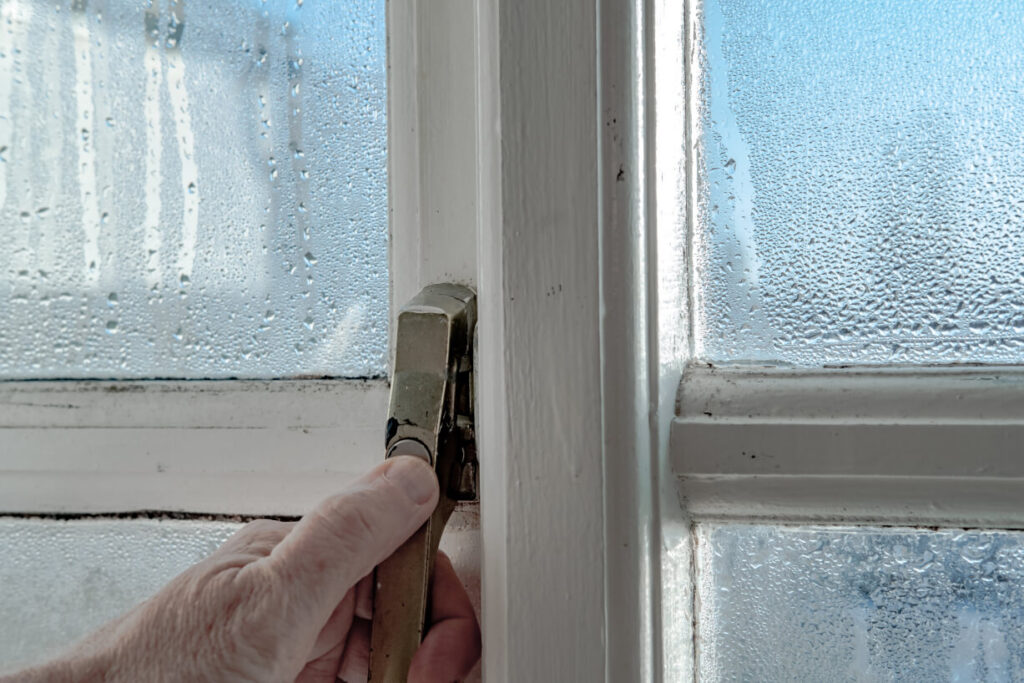As we discussed in our other blog, “Trapped condensation between double-glazing window panes”, condensation, particularly on window panes, is a common sight.
At different times of the year and in different situations, a certain amount of condensation is inevitable and harmless. However, excessive condensation can lead to multiple problems if not correctly managed and resolved.

Large amounts of condensation build-up regularly or for prolonged periods can affect the health of both the property and the occupant. Window timbers can rot, and sash windows repairs will be required; dampness can build up and transfer to masonry or surrounding structures; paint will become damaged, and moulds can build up. These moulds, alongside colder and more uncomfortable living conditions, lead to adverse health in the occupant – notably respiratory problems.
Air contains water vapour. The more it contains, the higher its humidity level. If we compare warm air with cold air, warm air is known to hold much more moisture in the form of water vapour.
So, what this means is that warmer air with a high humidity level may contain more water vapour than colder air would be able to hold. When that warmer air becomes cooler – like when meeting the surface of a cold window – it must ‘let go’ of some of its moisture. In the home, this is the condensation that we often see.
We can see examples of this all the time. The steam from a boiling pan of water will be very hot and might be at 100% humidity. It won’t be long before it meets with colder air and cool surfaces. Similarly, in the bathroom, hot steam from a nice bath will quickly fill the room and condense onto tiles, mirrors, and anywhere that lowers the air temperature and its water-retention levels (also known as ‘the dew point’).
Our other article covers the specific issue of condensation trapped between the panes of double-glazed windows, why this occurs, and what we can do to resolve this issue. But what about day-to-day condensation?
What can we do to manage condensation effectively and maintain healthy living conditions?
There are many factors of condensation and just as many different ways to respond. The architecture and construction of your property will contribute – e.g. how well do the property’s surfaces ‘breathe’? How well or poorly insulated are windows and walls? Is it naturally well ventilated? What is the building’s aspect, and how much sunlight and ‘solar gains’ does it receive? And so on…
Equally, the way the property is used will have a large impact on condensation. For example, is it currently serving as a busy office building? – In an active office, across an 8hr day, one person can exhale as much as 720ml of water into the office space (based on data from the Institute of Specialist Surveyors and Engineers). Does an occupant often dry the laundry inside? Is it a busy household with lots of cooking and frequent showers?
Whatever your lifestyle, it is important to understand how to keep living conditions healthy and enjoyable.
The advice can vary and, ultimately, the best advice will respond to each context. There are many different technological solutions that can help, such as dehumidifiers. However, whilst these interventions can be useful, they often address the symptoms (i.e. excess condensation), rather than the causes (i.e. why do you have excess condensation in the first place?).
Here, we look at the latter – how to address the root causes of condensation.
The main task is to reduce excessive moisture levels. Condensation hot spots such as kitchens and bathrooms will often benefit from mechanical/additional extraction measures such as extractor fans. Elsewhere, temperature and airflow/natural ventilation play important roles.
As we know, condensation occurs due to the combination of humidity levels, temperature, and temperature changes. Controlling these is a good path toward controlling condensation. Maintaining an ambient temperature and raising the temperature of surfaces can help. But keeping your heating bill and energy usage down is also important. Here, quality double-glazing will make interior panes warmer for longer and less susceptible to heat loss thanks to great thermal and insulative properties. You can also make some improvements to wall insulation by applying thermal wall coatings.
Effective ventilation will also allow you to control airflow more effectively and redistribute warm or cool air throughout the interior spaces. You can reduce condensation by moving humid air and reducing the build-up in areas prone to condensation. Windows that function well and can be easily opened and closed, alongside effective window draught-proofing to stop unintended airflow, will help you manage and maintain comfortable living conditions.
By exploring and experimenting with the fine balance between heating and cooling, combined with natural airflow, a little understanding of ‘condensation’, and professional upgrades, such as double glazing retrofitting, to your windows, you will be able to take control of your living conditions and the health of the property and its occupants.